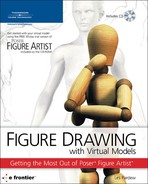Absorption, Reflection, and Pass Through
Light travels in a straight path from the light source until it hits something. When light hits an object, it will do one of three things: It will bounce off the object, it will be absorbed by the object, or it will pass through the object. In Figure 7.4, light is coming from the sun. When light hits the blue object, blue light is reflected to the viewer’s eyes. All non-blue light is absorbed into the object.
Figure 7.4. An object is blue because it reflects blue light.

The color of an object is determined by the light that is absorbed into it and the light that is reflected off of it. A white light contains all colors of visible light. If a white light strikes a blue object, all colors other than those that are blue will be drawn into the object. The blue light is reflected. What makes the object blue is that it is reflecting blue light, as shown in Figure 7.4.
Have you ever noticed that black clothing is much hotter to wear on a sunny day than white clothing? That is because black absorbs all of the visible light and doesn’t reflect any light. When light is absorbed into a surface, it creates heat. On the other hand, a white shirt reflects all of the light of the visible spectrum.
If the object is transparent, some of the light will pass through the object. In the case of a transparent object, such as glass, almost all of the light will pass through the object. Figure 7.5 shows light passing through the blue object. Not only is blue light reflected, but it is also the only light that passes through the blue object, as shown in Figure 7.5. All of the other light bands are absorbed into the blue object.
Figure 7.5. Blue light passes through the object.

